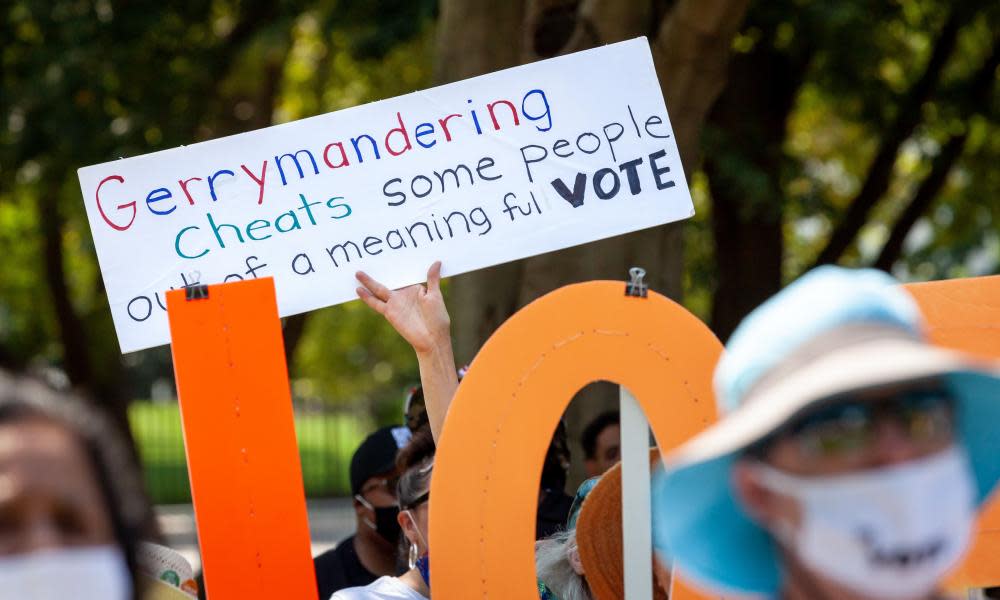This is what gerrymandering looks like

Hello, and Happy Thursday,
A few months ago, I sat down with my colleagues Alvin Chang and Andrew Witherspoon on the Guardian’s visual team asked to do something that I thought would be exceedingly difficult: could we show what gerrymandering looks like to our readers?
While there’s a growing awareness of how gerrymandering “debased” American democracy, in the words of supreme court justice Elena Kagan, articulating exactly how it works can be extremely difficult. The boundaries that make up our political districts are invisible, so when politicians move them every 10 years, voters don’t feel it in their everyday lives. Looking at gerrymandered districts can feel like you’re just looking at a bunch of squiggly lines (trust me, I’ve been there).
Over the last few weeks, Andrew put together four maps that overcome this problem. And the final product is, I believe, the best visualization of how gerrymandering works that I’ve seen to date.
We zoomed in on four districts – two in North Carolina and two in Texas – that provide some of the clearest examples of how politicians are gerrymandering this cycle. Using the 2020 election results and demographic data, we showed how politicians are transforming districts to virtually lock in election results for the next decade.
Just take a look at what happened to the sixth congressional district in the north-central part of North Carolina. It’s currently represented by Democrat Kate Manning, and Joe Biden won the district by 24 points in 2020, a sign that it’s a heavily Democratic area. But when Republicans in the state legislature drew the new lines, they cracked the district into four pieces. The Democratic voters in the sixth district were tossed into four districts that strongly favor the GOP, ensuring Republicans will have a powerful advantage in elections for years to come.
All four districts we focused on were drawn by Republicans, who have an immense advantage across the country in drawing district lines this year. But where Democrats do have the upper hand, in places like Oregon and Illinois, they’ve shown a willingness to gerrymander as well.
Amid the complexity of redistricting, there’s an important, and often ugly, story about how voters are grouped based on race. In north-eastern North Carolina, for example, we showed how Republicans lowered the share of Black voters in a district, probably making it harder for Black voters there to elect the candidate of their choice. GK Butterfield, a Black Democrat who has represented the district since 2004, is now likely to announce his retirement this week. While courts have historically protected the ability of Black voters to elect the candidate in their choice in the district, that’s now in jeopardy.
“I’m fairly certain that this district, if GK were to retire, would be a district that Black voters don’t have the opportunity any longer to elect their candidates of choice,” Allison Riggs, a prominent voting rights attorney at the Southern Coalition for Social Justice in North Carolina, told me last week.
We also showed how Hispanic voters in the Democratic-leaning suburbs of Dallas and Fort Worth are being tossed into a largely rural district where Republicans dominate.
Civil rights groups are bringing a flood of lawsuits to challenge these maps. But they face a huge uphill battle. In 2019, the US supreme court said for the first time that federal courts can’t address partisan gerrymandering. And while plaintiffs can challenge discriminatory maps on different grounds, those suits can take years to resolve in court, enabling politicians to hold several elections using discriminatory maps.
Reader questions
Robert writes: With all the talk about eliminating the filibuster, what do you suppose is going to happen to it if Republicans once again achieve a solid majority as now appears likely? Just sayin’.
This is a concern that some Democrats who defend the filibuster share. But those who support getting rid of the rule point out that Republicans have distorted the filibuster from a tool that is supposed to forge compromise to one that prevents the majority party from governing at all. And I think there’s also a belief that Republicans might be willing to do away with the filibuster when they get back into the majority, regardless of what Democrats do.
Please continue to write to me each week with your questions about elections and voting at sam.levine@theguardian.com or DM me on Twitter at @srl and I’ll try to answer as many as I can.
Also worth watching …
Ohio Republicans were so secretive in drawing new gerrymandered state legislative maps that they shut out members of their own party. Now, they’re pushing ahead with drawing a gerrymandered congressional map.
Georgia Republicans unveiled a new congressional map that heavily favors the GOP.
Civil rights groups have filed a challenge to Texas’s new electoral maps.

